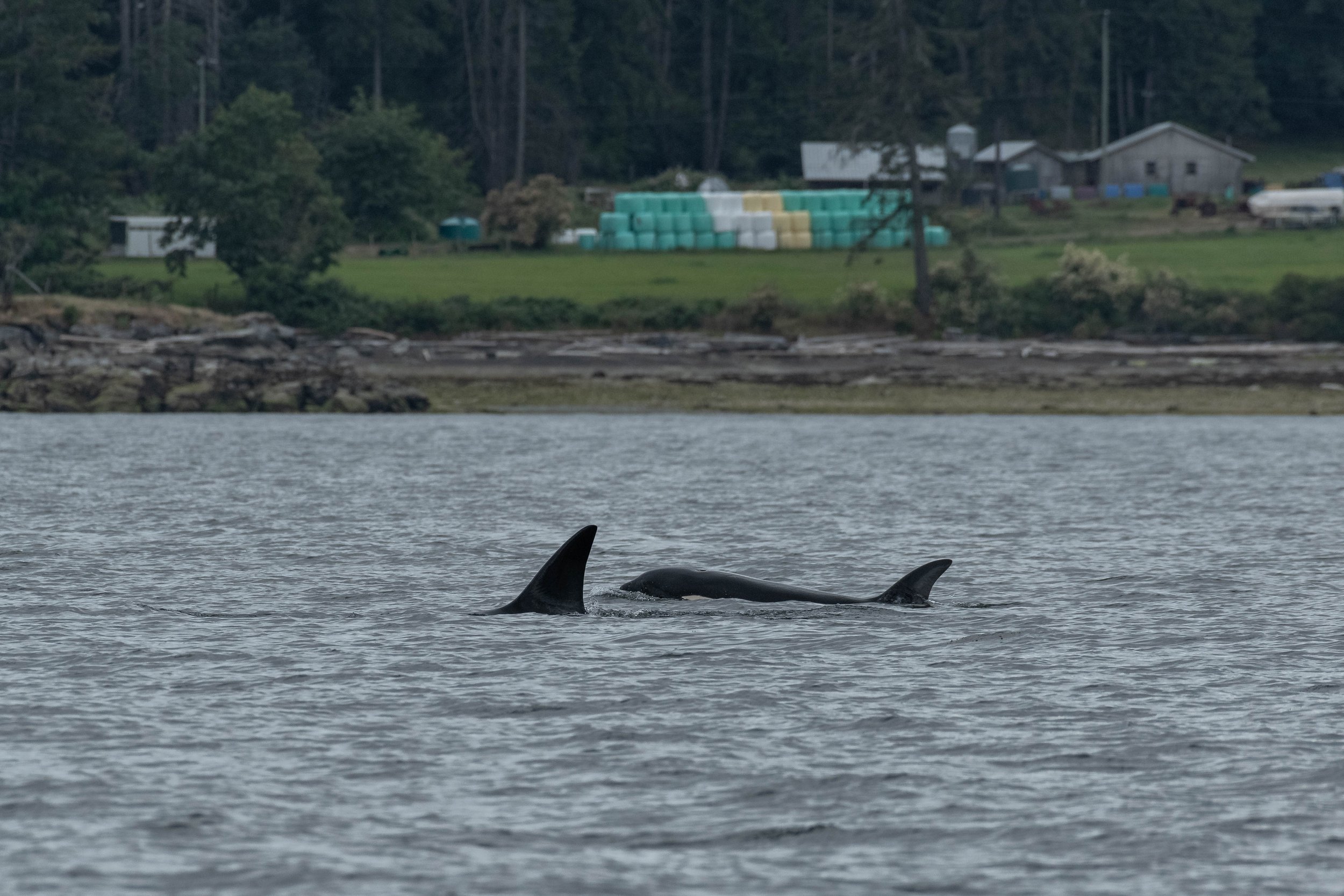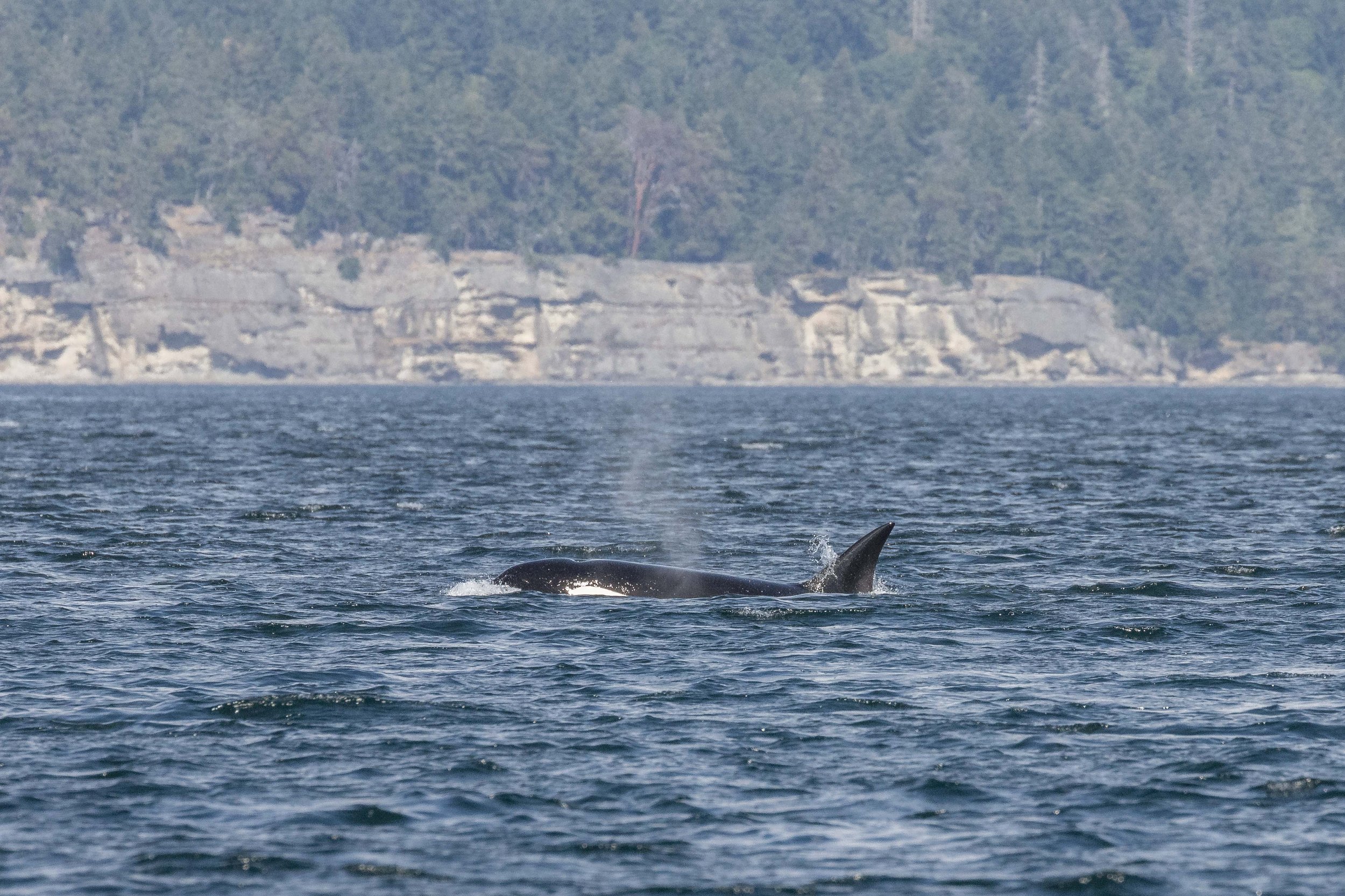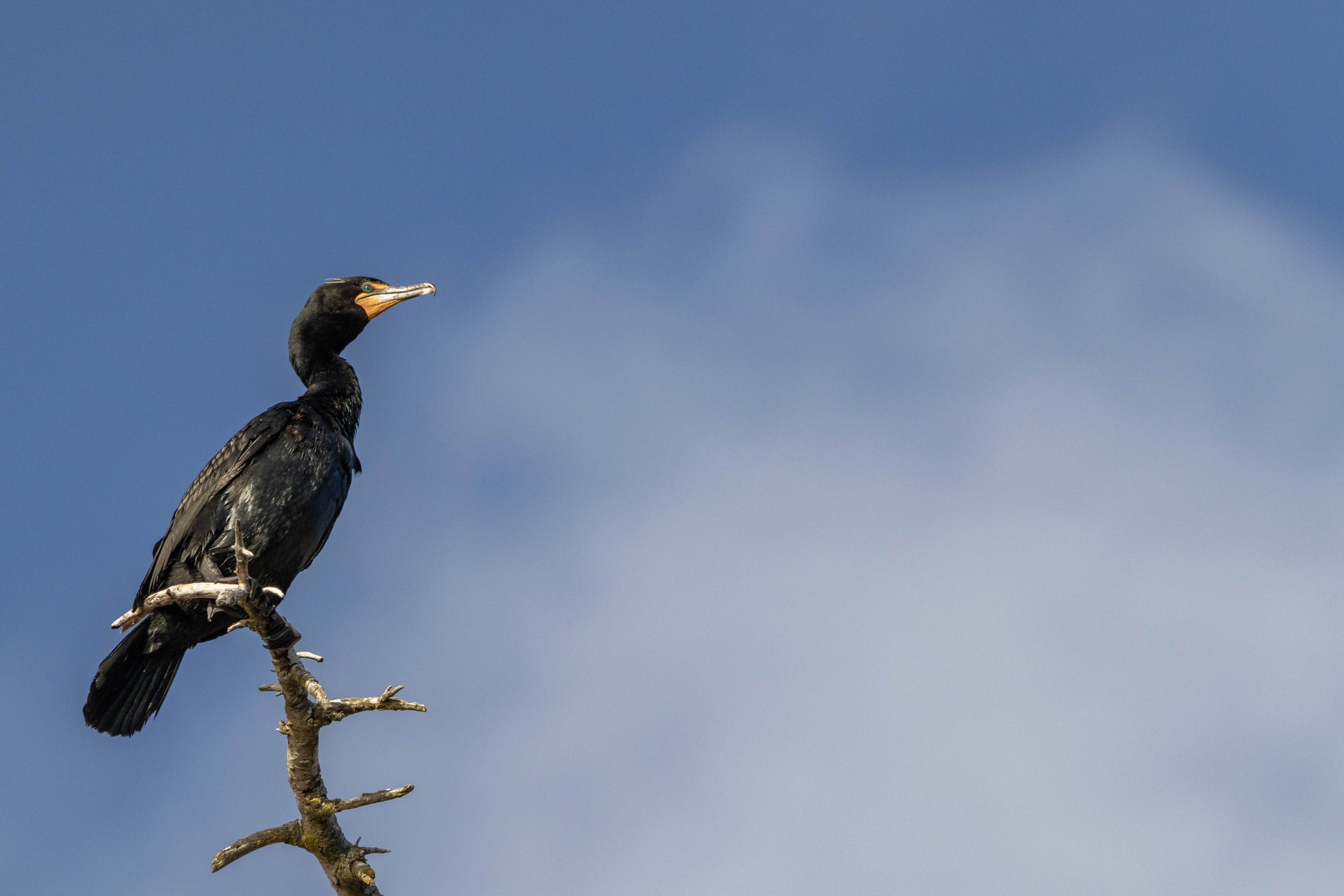June 22, 2024 - The T077s all day!
We didn’t have to go far to find whales today - as we pushed off the dock we immediately turned southbound towards Dodd Narrows where there was an early report of orca! Once we crossed the Narrows we found 4 small whales spread out. These 4 were identified as the T077s:
T077 Asja ♀ (1981)
T077C Neftali ♂ (2006)
T077D Alycon ♀ (2009)
T077E Misneach (2016)
This pod was busy travelling along when we observed them. Orca can travel over 100 km in a day, so if they have a certain destination in mind, they may end up spending most of their day just covering ground (er, ocean) to get there!
Of course, they will eventually need to take a break to grab a bite to eat. Luckily for these orca, there are many seal haulouts located all throughout the Gulf Islands, leading to lots of hunting opportunities for them. On average, every orca will need to eat from 200-400 lbs. of food every day to keep up their weight. That means this family will need to hunt 5-7 seals every day. When hunts can last anywhere from a few minutes to a couple of hours long, that can take up a lot of your day!
Once we departed the T077s we started searching for other wildlife to watch. The Rose Islets, a small Ecological Reserve inside the Gulf Islands, was our next stop where a bob of Harbour seals was hauled out up on the rocky shores. Many of these seals were quite round - we suspect they are pregnant, meaning we might get to see some adorable seal pups soon!
After departing our rotund seals we continued scanning as we headed out into the Strait of Georgia. We arched northwards towards another favourite wildlife stop - the lovingly named “Stinky Rocks”! This small islet chain is a haulout for many Steller sea lions and today was no different. There were easily over 100 sea lions grumbling, snoozing, fighting, or just relaxing on the rocks.
Near our trip's end, we quickly stopped to observe a local eagle nest. The pair of Eagles that calls this nest home has successfully raised one eaglet this year which we have been watching grow and learn in the past few months. Eaglets only stay in the nest for about 10-12 weeks so we won’t get to see this little one around for too much longer as it will be fledging soon, so we want to take every opportunity we can to peek at them!
Our afternoon trip went very similarly to our morning trip as we were able to relocate the T077s just south of where we left them behind this morning! What a lucky day!
Photos by Marine Naturalists Aly Kohlman, Vanessa Vereschahen, and Lucy Willis.
AM
T077 Asja surfacing. Photo by Aly Kohlman 10:30.
T077D Alycon has some new, deep scarring on her saddle patch. Photo by Aly Kohlman 10:30.
T077E Misneach. Photo by Aly Kohlman 10:30.
T077C Neftali surfacing with some spray. Photo by Aly Kohlman 10:30.
T077C Alycon’s eyepatch. Photo by Aly Kohlman 10:30.
T077 Asja surfacing in Stuart Channel. Photo by Aly Kohlman 10:30.
T077 Asja surfacing in front of T077E Misneach. Photo by Aly Kohlman 10:30.
T077 Asja travelling away from the boat. Photo by Lucy Willis 10:30.
T077 Asja with the water flowing off her back. Photo by Lucy Willis 10:30.
T077 Asja surfacing through a wave. Photo by Vanessa Vereschahen 10:30.
A powerful blow from T077D Alycon. Photo by Lucy Willis 10:30.
T077D Alycon with younger sibling T077E Misneach behind. Photo by Lucy Willis 10:30.
T077 Asja has a unique eye patch shape. Photo by Vanessa Vereschahen 10:30.
T077 Asja surfacing in Stuart Channel. Photo by Vanessa Vereschahen 10:30.
A wave created by T077 Asja surfacing. Photo by Vanessa Vereschahen 10:30.
Black Oyster Catchers looking for food in the mussel beds. Photo by Lucy Willis 10:30.
A happy little Harbour Seal. Photo by Lucy Willis 10:30.
A (pregnant?) Harbour seal heading into the water with a purple sea star beside them. Photo by Lucy Willis 10:30.
A great look at the sea star. Photo by Lucy Willis 10:30.
There’s huge variation in the coloration of the Harbour Seals. Photo by Vanessa Vereschahen 10:30.
A Harbour Seal playing with some seaweed in the water. Photo by Vanessa Vereschahen 10:30.
Flinging Seaweed! Photo by Vanessa Vereschahen 10:30.
This little Harbour Seal was watching us from the water. Photo by Aly Kohlman 10:30.
The Steller Sea Lions enjoying the day on the rocks. Photo by Aly Kohlman 10:30.
This big male was keeping a watch over the Haul-out. Photo by Aly Kohlman 10:30.
This Sea Lion was posing for us. Photo by Vanessa Vereschahen 10:30.
A Steller Sea Lion about to head into the water. Photo by Vanessa Vereschahen 10:30.
Sea Stars hanging out (literally) on the steep slope of the Gabriola Bluffs. Photo by Aly Kohlman 10:30.
A bald eagle watching us from the trees along the bluffs. Photo by Lucy Willis 10:30.
One of the Adult Bald Eagles sitting at their nest. Photo by Aly Kohlman 10:30.
A look at the young eagle in the nest. Photo by Vanessa Vereschahen 10:30.
PM
T077C Neftali travelling south. Photo by Vanessa Vereschahen, 3:30.
T077 Asja doing a quick surface. Photo by Vanessa Vereschahen, 3:30.
T077D Alycon surfacing in the waves. Photo by Vanessa Vereschahen, 3:30.
T077C Neftali surfacing with T077 Asja in front. Photo by Vanessa Vereschahen, 3:30.
T077C Neftai with his mom, T077 Asja in front. Photo by Vanessa Vereschahen, 3:30.
The whole family! T077 Asja leads followed by T077D Alycon, T077E Misneach, and T077C Neftali bringing up the rear. Photo by Vanessa Vereschahen, 3:30.
These Kayakers didn’t seem to notice T077 Asja surfacing behind them. Photo by Vanessa Vereschahen, 3:30.
T077D Alycon surfacing beside youngest member, T077E Misneach. Photo by Lucy Willis, 3:30.
T077 Asja. Photo by Lucy Willis, 3:30.
T077 Asja, T077C Neftali, and T077E Misneach surfacing together. Photo by Lucy Willis, 3:30.
T077 Asja. Photo by Lucy Willis, 3:30.
A Bald Eagle perched on the marker. Photo by Vanessa Vereschahen, 3:30.
Can you see the other Steller Sea Lions inside of this wave? Photo by Vanessa Vereschahen, 3:30.
Look at the size difference between the Adult Male and the Juvenile. Photo by Vanessa Vereschahen, 3:30.
A happy Steller Sea Lion. Photo by Lucy Willis, 3:30.
High Stepping Sea Lion. Photo by Lucy Willis, 3:30.
The baby eagle in the nest. Photo by Vanessa Vereschahen, 3:30.
One of the parents dropped off a snack for the youngster. Photo by Lucy Willis, 3:30.
The baby enjoying their snack. Photo by Lucy Willis, 3:30.
A Pelagic Cormorant Landing on the Cliff. Photo by Vanessa Vereschahen, 3:30.
A cormorant in flight. Photo by Vanessa Vereschahen, 3:30.
Double Crested Cormorant perched on a dead branch. Photo by Lucy Willis, 3:30.





















































